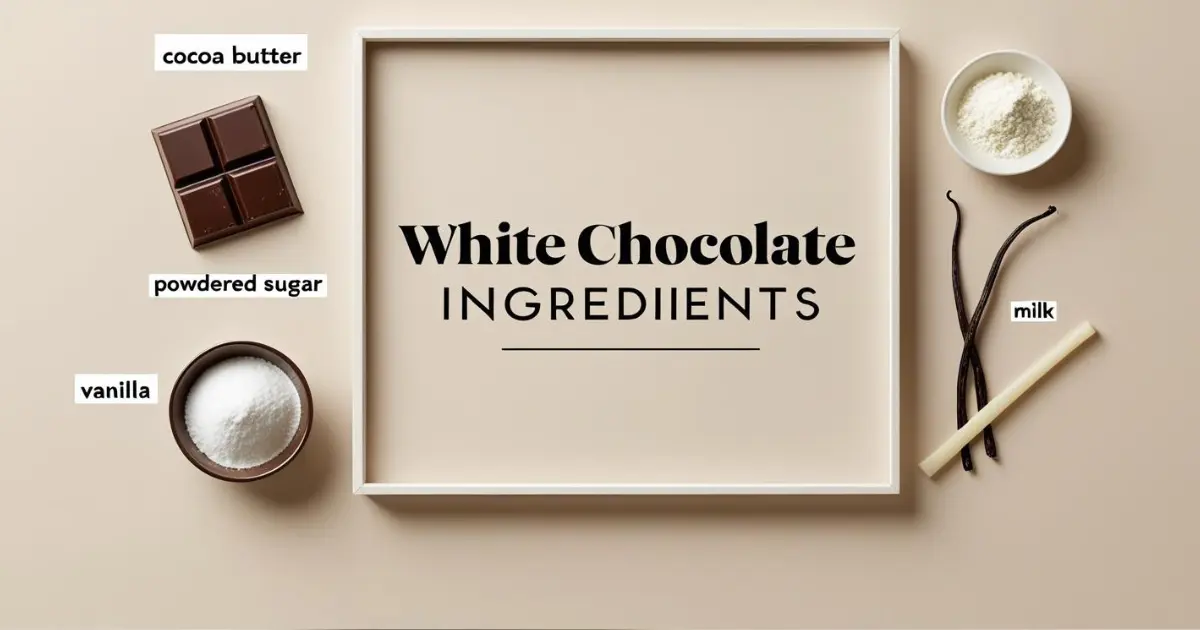Complete List of White Chocolate Ingredients Explained
A Creamy Memory That Started It All
The first time I tasted white chocolate, it wasn’t just the sweetness that caught me—it was the soft creaminess, the comforting aroma, and the way it melted so effortlessly on my tongue. It felt like a warm hug in dessert form. Unlike the deep richness of dark chocolate or the milky smoothness of milk chocolate, white chocolate was something else entirely—lighter, gentler, almost nostalgic.
But what gives white chocolate its delicate taste and silky texture? And is it really chocolate if it’s missing the signature cocoa flavor?
Let’s explore the full list of white chocolate ingredients, decode what each one does, and learn how this luscious confection is made from bean to bar.
Table of Contents
What Is White Chocolate Made Of?
Is White Chocolate Actually Chocolate?
Technically speaking, white chocolate is made from the fat of the cocoa bean, known as cocoa butter, but not the cocoa solids that give milk or dark chocolate their signature brown color and robust taste.
So while it doesn’t contain cocoa powder, it’s still considered chocolate by both the FDA (in the U.S.) and the European Union, as long as it meets specific ingredient thresholds. According to regulations:
- It must contain at least 20% cocoa butter
- At least 14% milk solids
- No more than 55% sugar or sweeteners
So yes—white chocolate is real chocolate, just a softer, sweeter kind.
Core White Chocolate Ingredients (Explained)
Understanding the main components helps you make better choices—whether you’re buying a gourmet bar or making your own from scratch.
1. Cocoa Butter: The Silky Base
- Extracted from cocoa beans during processing
- Pure, ivory-colored fat (not chocolatey in taste)
- Provides white chocolate with its melt-in-your-mouth texture
- Must make up at least 20% of the product to be legally called white chocolate
Cocoa butter is the most luxurious part of the cocoa bean, and it’s what gives white chocolate that iconic creamy, smooth mouthfeel.
2. Milk Solids: The Creamy Flavor
- Typically added in the form of whole milk powder, nonfat milk powder, or concentrated milk
- Contributes to the rich dairy flavor and soft texture
- Also helps with structure during tempering and molding
This is the key reason white chocolate feels creamy on the tongue—it’s a blend of dairy and fat, harmonized together.
3. Sugar: Sweetness Central
- Commonly refined cane sugar or beet sugar
- Makes up the bulk of the recipe—often between 40% and 55%
- Balances out the mildness of cocoa butter and milk solids
Without cocoa solids to balance it, white chocolate tends to be sweeter than milk or dark chocolate. It’s why it pairs so well with tart fruits or salt.
4. Lecithin: The Texture Hero
- Usually soy lecithin or sunflower lecithin
- Acts as an emulsifier, helping fat and water mix smoothly
- Typically less than 1% of the final recipe
While you barely taste it, lecithin makes a huge difference in creating a bar that’s glossy, smooth, and stable.
5. Vanilla or Vanillin: The Finishing Touch
- Can be real vanilla extract or synthetic vanillin
- Balances sweetness and enhances aroma
- Used in very small amounts, but makes a noticeable flavor difference
Vanilla adds the familiar warm note that blends everything together, completing the taste we associate with white chocolate.
Ingredient Table – Sample White Chocolate Composition
| Ingredient | Function | Typical Percentage |
|---|---|---|
| Cocoa Butter | Texture, base fat | 20–35% |
| Sugar | Sweetener | 40–55% |
| Milk Solids | Creaminess & flavor | 14–20% |
| Lecithin | Emulsifier | <1% |
| Vanilla/Vanillin | Flavor enhancer | <1% |
Commercial vs. Artisan White Chocolate
Commercial Brands
- Often include flavor enhancers, preservatives, and artificial vanillin
- May use low-cost milk powders and stabilizers for extended shelf life
- Prioritize cost and durability over pure flavor
Artisan or Premium Brands
- Use real vanilla, high-quality cocoa butter, and natural milk powders
- Typically free from artificial additives or preservatives
- Have shorter ingredient lists and focus on flavor integrity
Tip: Look at the label. The more recognizable and natural the ingredients, the better the chocolate.
How Each Ingredient Affects Taste & Texture
Why Is White Chocolate So Sweet?
Because it lacks cocoa solids, it doesn’t have any natural bitterness to balance the sugar. Combined with creamy milk solids and aromatic vanilla, this creates the ultra-sweet profile many people associate with white chocolate.
What Makes It So Creamy?
Cocoa butter is a fat that melts just below body temperature. That’s why white chocolate melts beautifully on your tongue. Lecithin ensures it melts evenly and doesn’t separate during processing.
Dietary Considerations & Allergen Alerts
Common Allergens in White Chocolate
- Milk: It’s not dairy-free or vegan unless specified
- Soy: Lecithin often comes from soybeans
- Gluten-free: Usually yes, but check for cross-contamination
Vegan or Dairy-Free Options
Some innovative brands now make vegan white chocolate using:
- Coconut milk powder
- Rice or oat milk powder
- Cocoa butter + natural sweeteners
These are a great alternative for those avoiding dairy but still craving that creamy sweetness.
Types of White Chocolate for Different Uses
| Type | Cocoa Butter? | Best Use |
|---|---|---|
| Baking Chips | Yes | Cookies, muffins |
| Couverture | Yes (high %) | Dipping, ganache |
| Candy Melts | Often No | Decorations, molds |
Note: Candy melts may look like white chocolate, but they often use vegetable fats like palm oil instead of cocoa butter.
Quick Homemade White Chocolate Recipe
Want to try making it yourself? Here’s a simple white chocolate recipe:
Ingredients Table
| Ingredient | Amount |
|---|---|
| Cocoa Butter | 100g |
| Powdered Sugar | 60g |
| Milk Powder | 40g |
| Vanilla Extract | 1 tsp |
| Lecithin | ½ tsp (optional) |
Instructions
- Melt cocoa butter over a double boiler until smooth
- Add sugar and milk powder gradually while stirring
- Mix in vanilla and lecithin (optional for texture)
- Pour into molds and refrigerate until set
Enjoy your creamy homemade white chocolate as-is, or use it in recipes!
Frequently Asked Questions – White Chocolate Ingredients
What are the main ingredients in white chocolate?
White chocolate is made from cocoa butter, milk solids, sugar, lecithin, and vanilla.
Does white chocolate contain cocoa?
Yes, it contains cocoa butter, which comes from the cocoa bean, but it does not contain cocoa solids like milk or dark chocolate.
Is white chocolate vegan?
Traditional white chocolate is not vegan due to its milk content. However, vegan-friendly versions exist using plant-based milk powders.
Why is lecithin used in white chocolate?
Lecithin is an emulsifier that helps blend ingredients smoothly, giving white chocolate its creamy texture.
What’s the difference between cocoa butter and cocoa solids?
- Cocoa butter: Fat from the cocoa bean, used in white chocolate
- Cocoa solids: Non-fat part, gives chocolate its dark color and intense flavor (not present in white chocolate)
Final Thoughts: A Sweet Treat with a Simple Story
White chocolate may seem like a mystery to some, but it’s simply a careful balance of cocoa butter, milk, and sugar, often elevated with a dash of vanilla and emulsifier. Whether you love its mellow, buttery taste or prefer a darker bite, understanding the ingredients helps you enjoy it in a deeper, more intentional way.
So the next time you unwrap a piece of white chocolate—or stir it into your baking—know that there’s more behind the sweetness than meets the eye.
How Is White Chocolate Different from Milk Chocolate?

Spread the loveHave you ever taken a bite of silky, sweet white…
🧁 What Is White Chocolate Made Of? The Sweet Secret Behind Its Creamy Magic

Spread the loveHave you ever taken a bite of smooth, melt-in-your-mouth white…
Why Sugar and Sparrow’s Vanilla Cake Is Worth Trying

Spread the loveThe Magic of a Perfect Vanilla Cake There’s something undeniably…




